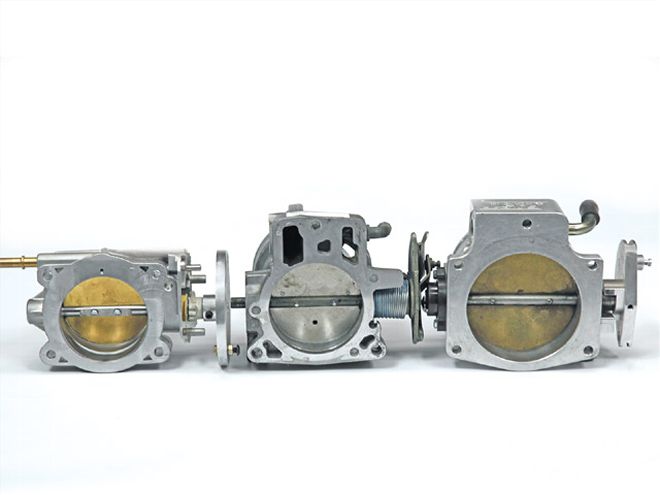
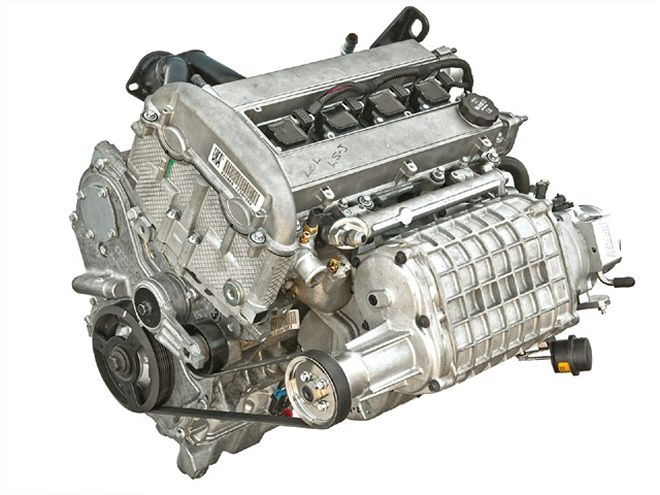 Our GM 2.0L Ecotec produced 372 hp and 292 lb-ft from 122 ci with basic bolt-ons.
Our GM 2.0L Ecotec produced 372 hp and 292 lb-ft from 122 ci with basic bolt-ons.
Developed by an international A-team of GM engineers and then refined by Lotus Engineering, the DOHC four-cylinder Ecotec is considered by the General to be the small-block Chevy of four-cylinders. A true world- class engine design, Ecotecs use an aluminum block and head and so far have been offered in displacements ranging from 1.8 liters to 2.4 liters. Although the vast majority of Ecotecs are normally aspirated with cast bottom ends, special high-performance supercharged and turbocharged variants have been produced with forged rotating components. So far, the hottest U.S. version is the 2.0L LNF first introduced in 2007. The 9.2:1, 2.0L motor is rated at 260 hp and 260 lb-ft, thanks to a turbocharger, direct injection, and a variable-valve-timing valvetrain. There are few nonstock parts available for this latest evolution, although that will almost certainly change in the future.
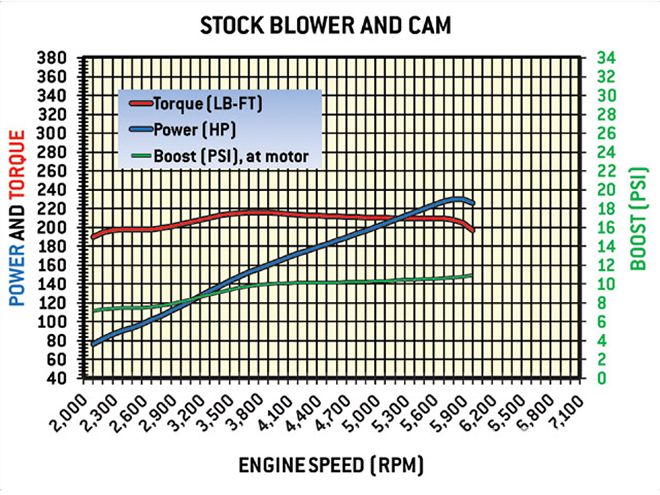
In the meantime, the hottest Ecotec that enjoys aftermarket support is the supercharged LSJ 2.0L (121.9ci) version available from '04 through '07 in the Saturn Ion Red Line and Chevrolet Cobalt SS CC. Crate motors were also available for a while through GM Performance Parts. Named one of Ward's 10 Best Engines in 2006, the square (3.386-inch bore x 3.386-inch stroke) LSJ was factory-redlined at 6,500 rpm; thanks to its stock Eaton supercharger and 9.5:1 compression, it made 205 net horsepower at 5,600 rpm with 200 net lb-ft on tap at 4,400.
 Throttle bodies, from left: The stock M62 LSJ blower uses a 67mm unit; the MP90, a Camaro LS1 75mm; and the 1900, a 90mm FAST unit. Originally drive-by-wire units, the LSJ and Camaro bodies were were gutted to work with the dyno's manual throttle cable.
Throttle bodies, from left: The stock M62 LSJ blower uses a 67mm unit; the MP90, a Camaro LS1 75mm; and the 1900, a 90mm FAST unit. Originally drive-by-wire units, the LSJ and Camaro bodies were were gutted to work with the dyno's manual throttle cable.
LSJs still have a conventional (nonvariable) valvetrain and sequential port fuel injection. There are lots of them around, and the basic technology is well-proven. This package forms the basis for many successful sport-compact racers. HOT ROD decided to check out an LSJ, raising its output with bolt-ons without getting in the long-block--all while retaining at least marginal streetability.
We tested on Duttweiler Performance's Henan-Froude F24 dyno controlled by Digalog/AVL control software. Rockett Brand 100-octane unleaded gas was used for all tests. The timing and fuel curves were optimized as needed via a MoTeC M800 ECU, but a stock GM ECU reflashed with HP Tuners software will also work (the MoTeC made dyno testing easier and quicker). Otherwise, the engine used all the stock sensors except the factory mass airflow unit, which was discarded in favor of a wide-band two-bar MAP sensor.
Stock Blower, GM Cams
The LSJ comes from GM with an Eaton M62 (62ci) Roots-style supercharger, a pressed-on 3.4-inch-od drive pulley, and a 67mm throttle body. Those were left in place for our baseline test, though. On the dyno, PaceSetter headers and a Flowmaster muffler replaced the stock exhaust manifold and catalytic converter.
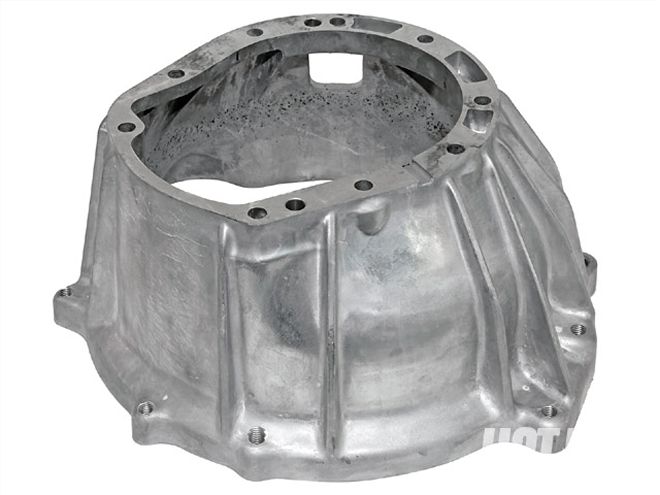 We needed a rear-wheel-drive (RWD) bellhousing to mount the Ecotec on the dyno. It turns out there's a stock RWD setup: The Pontiac Solstice and Saturn Sky (GM PN 89060089) fit the production Aisin five-speed. Want one for a GM T5? Contact Quad 4 Rods (PN ECT5).
We needed a rear-wheel-drive (RWD) bellhousing to mount the Ecotec on the dyno. It turns out there's a stock RWD setup: The Pontiac Solstice and Saturn Sky (GM PN 89060089) fit the production Aisin five-speed. Want one for a GM T5? Contact Quad 4 Rods (PN ECT5).
Using the hot rod SAE J-607 correction factor, in this configuration the engine generated 229.5 hp at 5,900 rpm with 215.9 lb-ft on tap by 3,800. Max boost with the factory supercharger configuration topped out at 10.9 psi, and total timing was 25 degrees. Generally, SAE J-607 corrections yield numbers about 4 percent higher than SAE J-1349, the net power standard used by the manufacturers to rate today's engines. Under J-607, the original 205hp/200-lb-ft factory advertised numbers would be around 213 hp and 208 lb-ft--so the PaceSetter mufflers and Flowmaster muffler appear to be worth approximately 17 hp and 18 lb-ft more than the stock exhaust configuration. This is also reflected in the slight reduction in observed boost: 10.9 psi versus the 12 psi we've seen on typical factory LSJ setups indicates less overall flow restriction. Note, too, the very broad, flat torque curve (graph).
Stock Blower, Comp Cams
We next stepped up with a hotter cam. On the four-valve, DOHC Ecotec, this can get a little tricky. First, basic cam cores vary on different models due to changes in timing gears, camshaft position sensors, and whether the rear of the cam drives any external accessories.
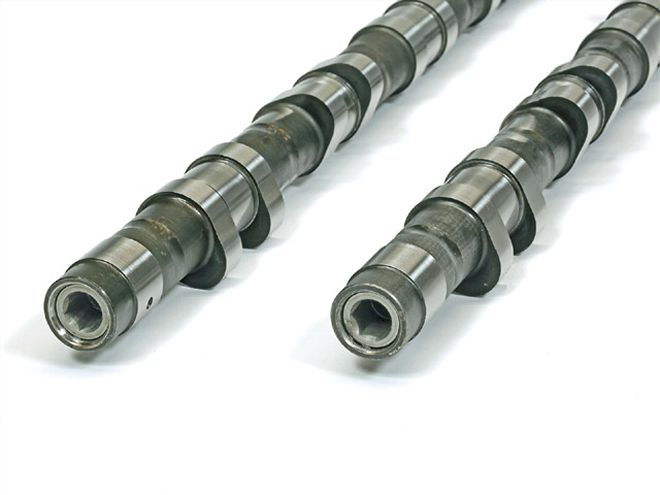 When ordering Comp Ecotec cams, be sure to specify the exact application. On the LSJ, the intake and exhaust cam castings are the same length (unlike many normally aspirated Ecotecs), and both LSJ cams should have a pressed-in hex at the rear (the LSJ exhaust cam hex drives a cam-location sensor).
When ordering Comp Ecotec cams, be sure to specify the exact application. On the LSJ, the intake and exhaust cam castings are the same length (unlike many normally aspirated Ecotecs), and both LSJ cams should have a pressed-in hex at the rear (the LSJ exhaust cam hex drives a cam-location sensor).
Second, Ecotec cams don't need big lift numbers because of the greater area envelope generated by two intake and two exhaust valves. Another plus is that the small, lightweight valves and overhead cam allow the small stock valve-springs to work through at least 7,000 rpm.
Third, Ecotecs use variable-geometry cam followers that generate a peak ratio of about 1.69:1. The variable geometry changes the effective ratio during the cam cycle, so a given cam's listed opening and closing points are taken at the valve instead of at the cam-lobe checkpoint used on pushrod engines. This makes Ecotec cam durations seem larger than they really are.
Keeping these factors in mind, we ordered a Comp Xtreme Energy XE252BHR-13 cam set (see spec chart). The listed catalog part number is intended for most normally aspirated Ecotecs that use dissimilar-length cams, and won't fit the LSJ head, so as of this writing, the LSJ version is a custom-order part.
The new cam set liked 27 degrees of total timing and still generated 11 to 12 inches of idle vacuum (use a vacuum pump if operating power brakes). The peak power point jumped by 700 rpm to 6,600 rpm, where the new cams generated 265.2 hp, a gain of nearly 36 over the stockers. Likewise, torque was up about 11 numbers to 227.1 lb-ft at 3,900 rpm, a 100-rpm increase over the previous peak point. Although the engine was stronger in the midrange and top end, the gains were made at the expense of less power below 3,500 rpm.
Click here for the Ecotec cam specs
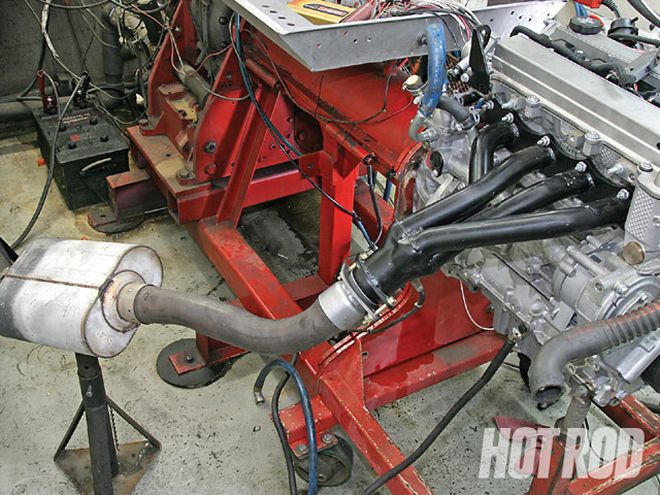 PaceSetter's reasonably priced header for the '05 to '06 2.0L supercharged Cobalt SS has 1 3/4-inch primaries and a 3-inch collector (PN 70-1273, black; PN 72C1271, Armor Coat). On the dyno, we ran it through a Flowmaster Super 44 muffler with a 3-inch inlet and outlet.
PaceSetter's reasonably priced header for the '05 to '06 2.0L supercharged Cobalt SS has 1 3/4-inch primaries and a 3-inch collector (PN 70-1273, black; PN 72C1271, Armor Coat). On the dyno, we ran it through a Flowmaster Super 44 muffler with a 3-inch inlet and outlet.
Magnuson MP90 Blower
Moving up to a larger blower could restore the bottom end as well as eke out gains on the top. Magnuson superchargers are based on the same high-tech Eaton blowers used in production cars but with hot rod-friendly features such as a choice of inlets and bolt-on drive pulleys. The MP90 (90ci) supercharger is capable of supporting 800 hp on a 400ci GM Gen III small-block--more than enough for a 122ci Ecotec.
With a 3.6-inch pulley and 75mm Camaro LS1 throttle body, the MP90 developed just shy of 23 pounds of boost at the blower. However, this dropped to about 20.6 psi at the engine, indicating the stock inlet manifold and small integral intercooler cartridges were a restriction. More boost was only heating the air, not developing more power. The idea is to make as much power as possible with as little boost as possible.
Despite this restriction, the MP90 was worth nearly 70 hp and 60 lb-ft. The 285.1-lb-ft torque peak occurred 1,700 rpm higher; 333.5 hp was generated at 6,800 rpm, a 200-rpm gain over the previous peak. On the low end, power and torque exceeded even the original baseline starting at 2,200 rpm.
Magnuson 1900 TVS Blower
If the MP90 was good, the Magnuson four-lobe TVS 1900 (1,900cc or 115.9ci displacement) should be even better. Once again, there was about a 2-psi difference between boost at the engine and boost at the blower, indicating less than optimum efficiency. Nevertheless, we were able to make about 22.9 psi with a 3.6-inch pulley without excessive charge-air heating. Swapping to a 3.2-inch pulley, we raised boost as high as 30 psi without making any more power, just heating up the air.
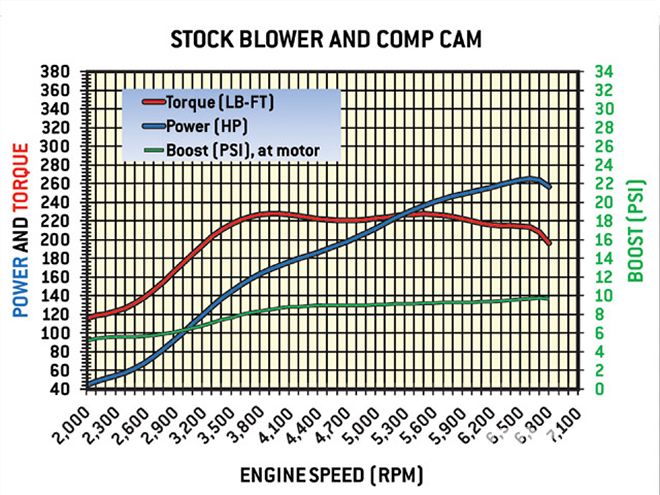
At 22.9 psi and with 24 degrees of timing, the 1900 was worth 6.5 lb-ft and at least 38 hp over the MP90. We say at least because the big number occurred at 7,100 rpm with the curve still ascending. Call us wimps, but with the stock valve-springs still in play, we didn't want to run the engine any higher for fear of getting into valve float. At this point, aftermarket valvesprings are strongly advised.
The engine was now making more than 250 hp starting at 4,700 rpm and more than 300 hp by 5,500. As for torque, we were seeing at least 250 lb-ft by 3,700 rpm. The new peaks were 291.6 lb-ft at 5,800 rpm (up 200 rpm) and 371.9 hp at 7,100 rpm (up 300 rpm). Nevertheless, the engine made more power and torque at every rpm checkpoint than any of the previous combinations.
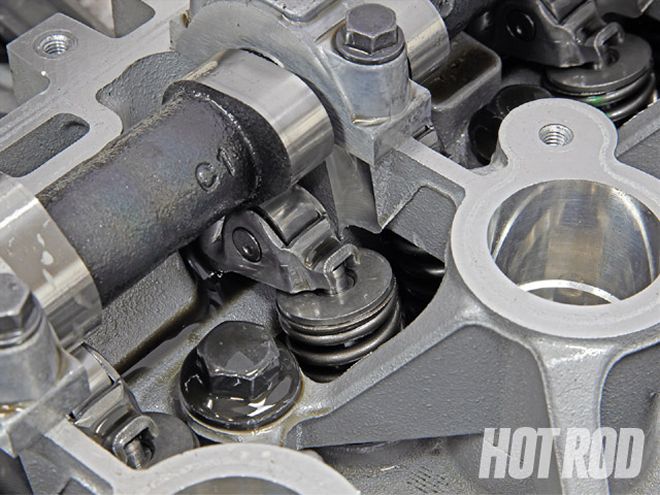 The overhead cam follower's geometry escvaries the amount of ratio during the opening and closing cycle. One end of the follower has a hydraulic piston; the whole assembly is equivalent to a flat-tappet hydraulic roller lifter and rocker arm. The valvesprings seem small, but they were good through 7,000 rpm.
The overhead cam follower's geometry escvaries the amount of ratio during the opening and closing cycle. One end of the follower has a hydraulic piston; the whole assembly is equivalent to a flat-tappet hydraulic roller lifter and rocker arm. The valvesprings seem small, but they were good through 7,000 rpm.
That's Power, Baby
When you're used to 350ci-plus engines, 372 hp may not seem like a big deal. But let's put this in perspective: In American terms, 2.0 liters come out to about 122 ci. So at 372 hp, we are looking at more than 3 hp/ci. A typical blown 350 Chevy running 100-octane unleaded might make about 650 hp with a Roots supercharger and still remain marginally streetable. That's just under 2 hp/ci.
And there's a lot more left. The limiting factors at this point are a restrictive inlet with undersized intercoolers and a cam slightly too small to fully optimize the larger blower. If you have cash to burn, a fabricated intake plumbed to an external intercooler, even hotter cams with matching valvesprings, and some head porting could very well push this 122ci mill past the 500hp mark using the 1900 blower. As is, the present combo would make a very nice cruising package in a lightweight track roadster, with potential 30-plus mpg on tap to boot.
More Information
Available through GM dealers such as Burt Chevrolet and Scoggin-Dickey:
* Ecotec 2.0L LSJ Power (GM PN 88958686): step-by-step guide to boosting the horsepower and torque of the 2.0L LSJ, including building a 300hp Ecotec; has detailed engine installation and removal instructions
* GM Sport Compact Performance Build Book, Third Edition (GM PN 88958728): describes all parts and procedures needed to build a drag racing or drifting-competition Ecotec; includes race mods for the 4T65E auto trans
* Solstice Performance (GM PN 88958697): beginning-to-expert tech info on boosting the Pontiac Solstice's performance capabilities; includes SCCA road racing, drifting, and brute-performance buildups